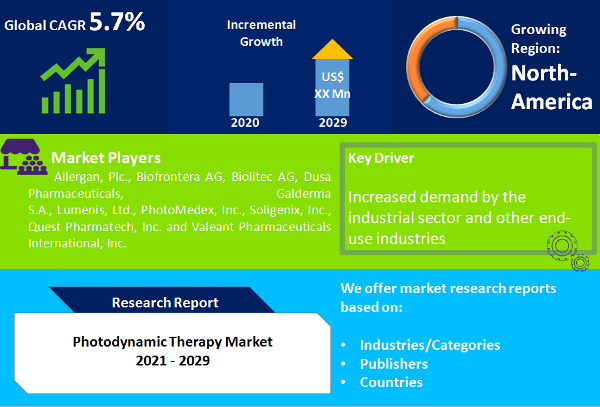Industry Outlook
The photodynamic therapy market is set to grow at an impressive rate with a compounded annual growth rate (CAGR) of 5.7% during the forecast period from 2018 to 2026. As per the statistics provided by World Health Organization (WHO), currently 2 to 3 million non-melanoma and 132,000 melanoma skin cancer occurs throughout the globe annually. Photodynamic therapy (PDT) is a treatment option for treating disorders related to skin and eye. It involves the use of a photosensitizing drug which gets stimulated on exposure to light of a certain wavelength for the generation of radical oxygen species which is actively engaged in killing cancerous cells.

"Negligible toxicity and ability to product reactive oxygen species to promote cell death in tumors drive the photosensitizer drugs market"
Photosensitizer drugs are reigning the product segment for photodynamic therapy market. The inherent attributes possessed by photosensitizer drugs such as negligible toxicity and ability to product reactive oxygen species to promote cell death in cancer cancerous cells drive the photosensitizer drugs market. Third generation photosensitizers are available for the treatment of skin and eye disorders. They are employed for the targeted cell destruction topically and intravenously. Laser devices are required to stimulate the photochemical reaction after the administration of photosensitizer drugs. Laser diode emitting wavelength in the range of 733 nm are widely preferred in the photodynamic therapy.
"Increasing popularity of photoimmunotherapy to propel the oncology market"
Presently oncology is leading the application segment for photodynamic therapy (PDT) market. Photoimmunotherapy is a treatment protocol which employs photodynamic therapy in conjunction with immunotherapy for tumor suppression. The combined therapy is useful in the stimulation of immune system which has a synergistic effect in the treatment of metastatic cancer. Photodynamic therapy also prevents cancer by shrinking of blood vessels providing nutrients to the tumor. In dermatology PDT is employed for the treatment of pathological conditions such as acne and psoriasis. Diligent research is being conducted in developing PDT as an antimicrobial therapy due to its ability to kill various drug resistant pathogens occurring on the skin surface and oral cavities. In ophthalmology PDT is employed for the treatment of wet age related macular degeneration (AMD), in which the photosensitizer drug (verteporfin) target the neovasculature that is caused in AMD.
"Rising prevalence of skin cancer to drive the photodynamic therapy market in North America"
In the current scenario North America is dominating the regional segment for photodynamic therapy market. According to American Academy of Dermatology (AAD), skin cancer is occurring in 1 in every 5 people in the United States during their lifetime. Rising prevalence of skin cancer and increasing number of diagnostic centers drive the photodynamic therapy market in North America. In Europe the market growth is determined by factors such as increasing number of people suffering with dermatological disorders and domicile of major players such as Allergan, Plc., Galderma S.A. and Biofrontera AG etc. Asia Pacific will be the fastest growing market during the forecast period on account of developing healthcare infrastructure and market expansion opportunities for key players specializing in photosensitizer drugs and laser devices.
Pharmaceutical companies actively engaged in providing products for photodynamic therapy are Allergan, Plc., Biofrontera AG, Biolitec AG, Dusa Pharmaceuticals, Galderma S.A., Lumenis, Ltd., PhotoMedex, Inc., Soligenix, Inc., Quest Pharmatech, Inc. and Valeant Pharmaceuticals International, Inc.
Historical & Forecast Period
This study report represents analysis of each segment from 2023 to 2033 considering 2024 as the base year. Compounded Annual Growth Rate (CAGR) for each of the respective segments estimated for the forecast period of 2025 to 2033.
The current report comprises of quantitative market estimations for each micro market for every geographical region and qualitative market analysis such as micro and macro environment analysis, market trends, competitive intelligence, segment analysis, porters five force model, top winning strategies, top investment markets, emerging trends and technological analysis, case studies, strategic conclusions and recommendations and other key market insights.
Research Methodology
The complete research study was conducted in three phases, namely: secondary research, primary research, and expert panel review. key data point that enables the estimation of Photodynamic Therapy market are as follows:
Market forecast was performed through proprietary software that analyzes various qualitative and quantitative factors. Growth rate and CAGR were estimated through intensive secondary and primary research. Data triangulation across various data points provides accuracy across various analyzed market segments in the report. Application of both top down and bottom-up approach for validation of market estimation assures logical, methodical and mathematical consistency of the quantitative data.
| ATTRIBUTE | DETAILS |
|---|---|
| Research Period | 2023-2033 |
| Base Year | 2024 |
| Forecast Period | 2025-2033 |
| Historical Year | 2023 |
| Unit | USD Million |
| Segmentation | |
Product
| |
Application
| |
|
Region Segment (2023-2033; US$ Million)
|
Key questions answered in this report